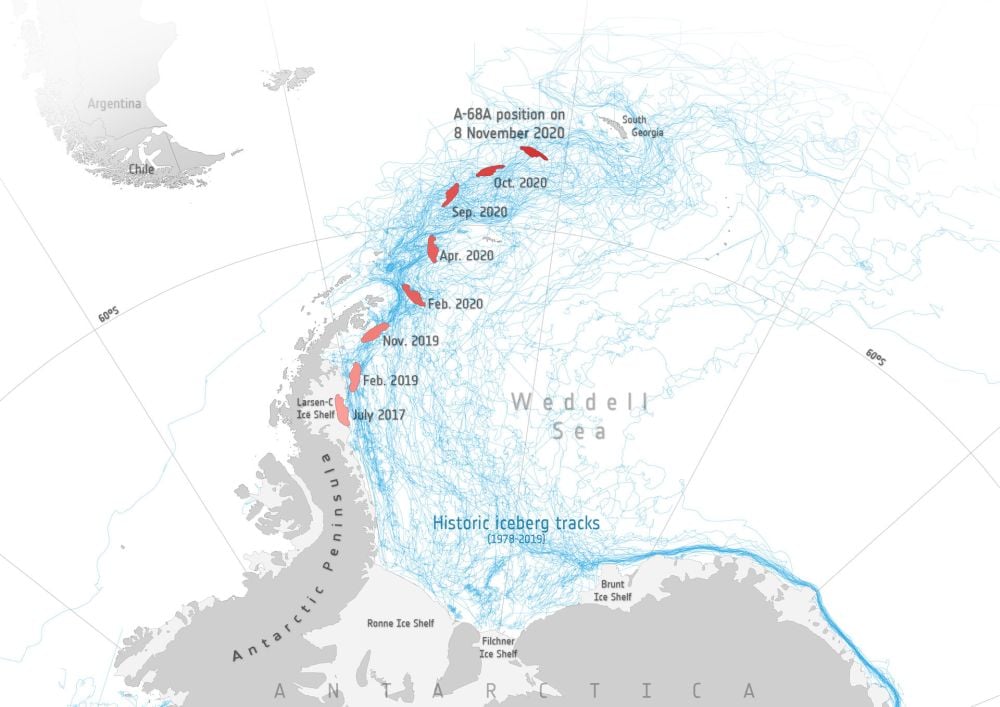Back in July 2017, satellites watched as an enormous iceberg broke free from Antarctica's Larsen C ice shelf on the Antarctic Peninsula. The trillion-ton behemoth has been drifting for over three years now. While it stayed close to its parent ice shelf for the first couple of years, it's now heading directly for a collision with South Georgia Island.
It could be a slow-motion collision, but a collision nonetheless. If it does collide with the island and its shallow sea-floor, it won't be the first iceberg to do so. And if the first one was any indication, wildlife could suffer.
The ESA's Copernicus Sentinel-1 satellite played a leading role in tracking the iceberg, named A68-A, as it slowly travelled toward South Georgia. A68-A is now only about 350 km away. There's a possibility that the currents could change, and the iceberg could veer away from the island and be taken away to the northwest, where it would eventually break up. But there's no guarantee.
A68-A is following a fairly standard route for icebergs that break off from the Larsen Ice Shelf. The leading image shows iceberg tracks in blue, as tracked by satellites over the years. Most icebergs pass by South Georgia uneventfully, but not all of them do.
Back in 1998, iceberg A38 broke off from Antarctica's Filchner-Ronne Ice Shelf and eventually split into two pieces, A-38A and A-38B. Both bergs moved north along the Antarctica Peninsula. A-38A drifted north and broke into pieces harmlessly, but A-38B took a different path. It also broke into pieces, but a portion of it left open seas and grounded on the shallow waters on the east of South Georgia Island.
That grounding was devastating for some wildlife. It parked itself on the foraging grounds for the island's penguins and seals. It stayed there for months, and many of the young seal pups and penguin chicks died because their parents were unable to feed them often enough. They were forced to detour around the iceberg, meaning many young died on the beaches waiting for their parents to return for food.
In an interview with the BBC, Professor Geraint Tarling of the British Antarctic Survey said, "When you're talking about penguins and seals during the period that's really crucial to them – during pup and chick-rearing – the actual distance they have to travel to find food really matters. If they have to do a big detour, it means they're not going to get back to their young in time to prevent them [from] starving to death in the interim."
By 2005, the iceberg was broken up and gone.
While that event was devastating for some wildlife, the new iceberg could be much more catastrophic. A68-A is the same size as South Georgia itself. Scientists are worried that if it grounds itself in shallow waters near South Georgia Island, it could stay there for 10 years. It's easy to see how that could wreak inter-generational carnage on the seal and penguin populations there.
But there's at least one reason to be hopeful. Though the seas around South Georgia are shallow, the iceberg itself may only draft 200 meters (656 ft.). It's possible that it'll float by the island completely, and loop around the island before drifting off to the northwest. Radar imagery also revealed a large crack in the iceberg, meaning wave action could break it apart sooner rather than later. "But it's very difficult to say precisely what will happen," Tarling told BBC News.
Fishing fleets will also be paying close attention to the iceberg's path. The seas around South Georgia Island are home to important fisheries of Icefish, Krill and Patagonian Toothfish. These are some of the most well-managed and sustainable fisheries in the world. According to the Government of South Georgia and the South Sandwich Islands, "It is home to some of the best managed, most sustainable, fisheries in the world."
There's no risk to any people. Wildlife is the only real permanent population on the island. At one time, a whaling station operated there at Grytviken, the island's best harbour. It also housed a research station and is the site of Ernest Shackleton's grave. In current times cruise ships visit the area. Researchers also visit the island to study its wildlife and biodiversity.
 Universe Today
Universe Today



